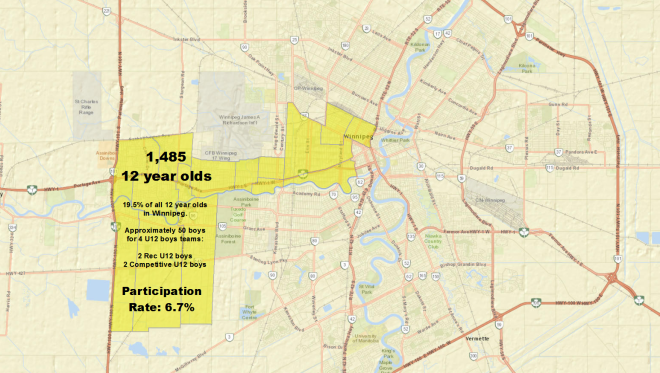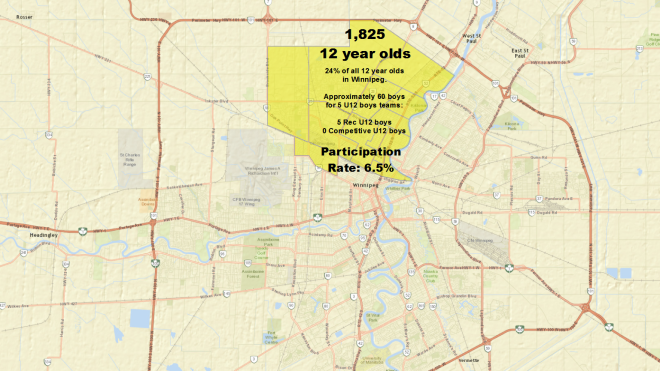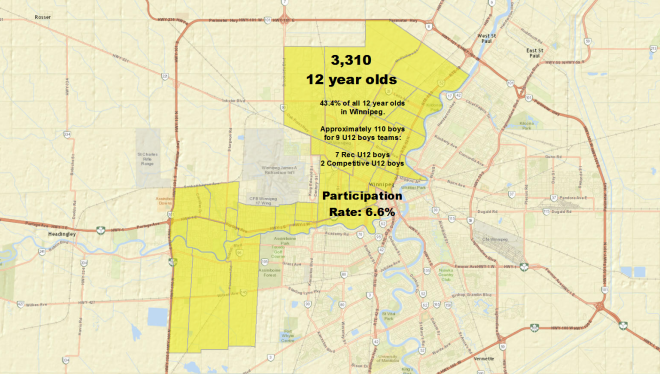I was sitting at my work station this morning thinking about the session I was planning to roll out tonight with my U12 boys rec team in preparation for the season kick off next week when I got “the email.” It was from a third parent in as many weeks notifying me that they were pulling their child from soccer to focus on various other “priorities.” Then I started to wonder if this was a unilateral decision or if the child was given any say in the matter? Does this parent offer their child any other opportunities for physical activity or promote healthy living in other ways? Without knowing all the facts, I felt sorry for the child, sorry he would miss out on the opportunity to be active, sorry he would miss out on the opportunity to meet new friends, sorry he would miss out on the opportunity to fall in love with the Beautiful Game!
My original roster of 13 players was now down to just 10 and we haven’t even played a single game yet. Being U12 and playing an 8v8 format that leaves me with a very lean roster even with perfect attendance and health. This got me thinking about the broader issue beyond just my team. Being a GIS Specialist, this of course meant I was thinking spatially. Using 2011 StatsCan census data, I examined the population by age within each soccer district in Winnipeg. Using this data I looked at 2015 outdoor soccer participation rates among U12 boys within my own district and that of a neighbouring district, the results are nothing short of disturbing!



Figure 1 illustrates the geographical reach of my soccer district and includes counts for total 12 year old population and the approximate U12 boys registration count to calculate their participation rate. Figure 2 and Figure 3 shows the same information for a neighbouring district and the two districts combined respectively. In all cases the total 12 year old population was halved on the assumption that the gender ratio was approximately 50/50. A fair assumption as this fits the general population models for Manitoba and Canada. To confirm, +/- 5% differences in the gender ratio were tested and resulted in a +/- 0.7% difference in the participation rates, a statistically insignificant difference.
I chose this temporal period and these geographies simply because I had the data readily available. Historically these two districts in Winnipeg have faced either socio-economic and/or organizational challenges that have hampered strong growth of their player bases thus they may not be entirely representative of Winnipeg as a whole. It would be interesting to complete this review for all 5 Winnipeg soccer districts for each gender and at each age group from U4 – U18 during both the summer and winter seasons.
So there you have it, a rather depressing 6.6% participation rate this summer among Winnipeg’s 12 year old boys in what is supposedly Canada’s fastest growing and most widely played game. I fully realize the dangers and limitations of extrapolating these temporal and spatial based results beyond Winnipeg and across Canada but it’s a start and an eye opener at that. As fortune would have it, I stumbled upon the Canadian Soccer Association (CSA) 2011 Annual Report titled, Momentum: A Game Changer. In it, the CSA claim that nationally 44% of Canada’s youth participate in soccer. My initial thought was what the heck is wrong with Winnipeg, considered by many a passionate soccer market. After regaining my wits, I called shenanigans on the CSA claim. To my luck they published stats on registered players by province and nationally. Again using publicly available 2011 census data from StatsCan and the CSA’s own published 2011 registration counts, I was able to calculate the youth soccer participation rates (combines males and females) for every province and Canada. The disturbing results are summarized below in Table 1.
With a national youth participation rate of 12%, this is a far cry from the 44% claimed by the CSA. As you can see the results are poor right across the board, particularly in the prairies and most disappointing in Manitoba. Keep in mind the numbers I present are for registered players. If the 44% claimed by the CSA was to somehow include a miraculous estimate of unregistered players as well, the results are even more disastrous suggesting that as many as 32% of youth would rather forgo participation in the structured youth soccer system. It’s a damning indictment of our system and the national and provincial governing bodies effectiveness to grow, promote and retain youth participation in the game of soccer.
Perhaps I’ve been harsh in suggesting a lack of growth in the game among Canada’s youth. Well as fortune would have it, yet another gem fell into my lap, this time from FIFA. In the July 2007 edition of FIFA Magazine an article titled BIG COUNT: 265 million playing football a 2006 national count of Canada’s registered youth soccer players was published. I calculated the national participation rate in 2006 using this data combined with the StatsCan 2006 census data to arrive at a participation rate of 12.03% shown below in Table 2.
Interestingly there were actually fewer registered players in 2011 then there were in 2006. This however is not surprising as it follows the decreasing youth population trend over the same time period. What is significant is the fact that there is a statistically insignificant decrease in youth soccer participation rates in 2011 from 2006 thus proving my point that no tangible growth has taken place in the game of soccer in Canada over this time period. It won’t be until the 2016 national census before we are able to see if any progress has been made.
So why all these numbers? Well this all began this morning while lamenting the loss of three of my players and the underwhelming registration numbers within my local soccer district and it just snowballed into a greater issue within my city, my province and my country. The CSA and its provincial member associations have been working very hard in recent years to bring about positive change in Canada’s youth soccer landscape. They have introduced arguably the greatest single advancement in Canadian soccer with the introduction of Long Term Player Development (LTPD), they recognize and are prioritizing the need for quality coach education and are working towards a national Club Charter model. These are great and necessary initiatives to improve the experience for our participants but do not address the root problem with soccer in Canada – growth. Canada has no cultural connection to the game of soccer, we don’t get excited about soccer like we do hockey. Until we establish a national pride and make soccer part of our cultural fabric it is forever destined to be a periphery sport in this country.
Being the soccer loving optimist I am, I’m not ready to call Canada’s youth soccer participation a bust but given the data available, my personal experiences as a coach, player and parent in the community, it seems far from a boom.



Kind of depressing indeed, James. The 5-year numbers in my district of the Central Okanagan reveal a similar flat line in terms of growth.
LikeLike
Robert, minimal as it may be, I suspect growth could be as simple as improved advertising for a start. Everyday I drive by large banners on city fences and small lawn signs at schools advertising football (American style) registration. Can’t speak to BC but youth football does very well for itself here in Manitoba. Perhaps it’s time we make as much effort to grow the game as we currently are too improve the experience for those already involved.
LikeLike
Same here for Canadian football, James. That culture is simply much stronger that the soccer culture that prevails in the Central Okanagan. Much to do, but the volunteer board members have all got to buy in first.
LikeLike
In addition, many of the volunteer board members need to look and act beyond their own kids involvement in the program. Interesting how few parents stay on youth sporting boards after their kids are no longer with the program. Kudos to those who do!
LikeLike
Hi coach! Good points, it is interesting because having relocated from a strong footballing culture in Southern California to Québec, the lack of support and decline in participation is sobering. Everyone has to chip in and as footballing structures, I feel we need to be “greedy”. We have to offer more and work with people who buy in to what we want to do. Offseason futsal, better parental education in the LOTG. What I see in QC is that there are many sporting options for kids. We need to give a reason for our players to stay with our clubs and at the expense of other sports, hockey or otherwise. Yes, loving the game and lifelong participation are legitimate aims, but what happens when we do not have enough of a player pool to truly push Canada to the next level? After Germany crashed out of the Euro 2000 tournament in last place, the player pathway the DFB laid out for its national teams and the Bundesliga was given a timeline of 10 years, it began to bear fruit in 02 and 06 but did not result in the World Cup until 2014. We are LESS than a decade away from the big show and even in Québec, there is still no approval for the participation of private academies in the competitive structure. In other words, at the national and provincial level we are still not casting our nets as widely as we could. If this is the case, why should we expect things to change? I respect other sports and coaches, but I am a football coach and love the sport, we need to play for keeps with as many communities as possible and as many programs as possible. Full stop. Keep it up coach.
LikeLike
Thanks for taking the time to read and comment. Agree 100%. We’re making progress in Canada… albeit at a snail’s pace… however I believe that no matter what policies be adopt or pathways we create, if they don’t involve embracing private enterprise we will never reach our fullest potential and will continue to alienate a large soccer playing population. It’s time the soccer community start working together for the betterment of the game and not against each other for self-interests.
LikeLike